- HOME
- ABOUT
- PERSONAL STORIES
- CAJUN
- LAS FLORES
- MIGHTY ONE
- WHARF RAT
- YALE STREET ICE HOUSE
- CAPTAIN CHAS. NOBLE
- A MIKI-MIKI TUG
- TAR-BABY
- NORTH ATLANTIC CONVOY
- OPERATION MULBERRY
- PEASOUP ON A POTATO PATCH
- S.S. CANBERRA’S FINEST HOUR
- ISCHIA
- THE F BOATS
- OCEAN LIGHTER
- ZAMBOANGA MONKEY CAPER
- TURMOIL ON TAWI-TAWI
- PIER-HEAD JUMP
- REQUIEM FOR A FRIEND
- FITCH THE BITCH
- WATER TAXI
- TALL TALES
- GALLERY
- GRATITUDE
- CONTACT
MIGHTY ONE
Ron Stahl
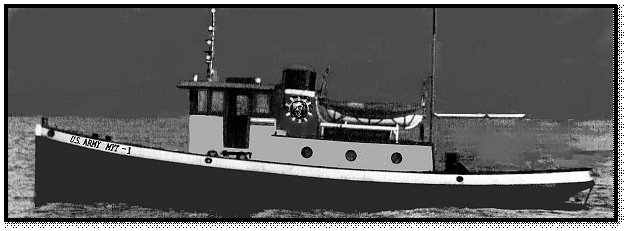
M.Y.T. 1 – 68-foot Motor Yard Tug-1
(Glossary of Nautical Terms at end of story)
The U.S. Army Transportation Service designates letters and numbers to identify the myriad of vessels in their fleet, much on the order of the U.S. Navy. Example; ST could indicate that the vessel was a ‘small tug’, a ‘steam tug’, or even a ‘steel tug’. Sometimes it can be more confusing when applied to vessels acquired from outside normal sources, such as constructed outside the US, confiscated or a donated hull.
I had just returned to Los Angeles with my shipmates after delivering a new Miki-Miki LT (Large Tug) to the East Coast. On our return, many of the men were assigned to ships heading out to the Pacific War Zones.
The Army’s Port Captain (civilian harbor-master of operations) indicated a need for an experienced water taxi operator to deliver passengers and cargo to
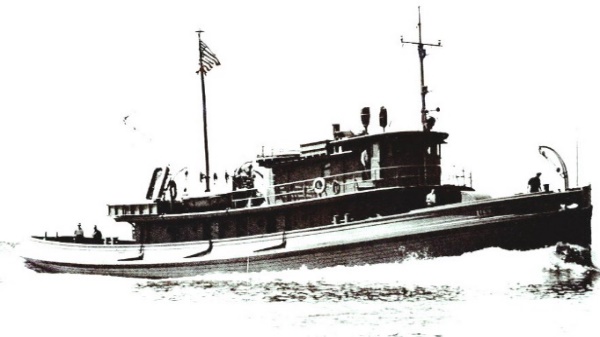
vessels at anchor in the outer harbor. He knew I ran the taxi before I signed on for the east coast delivery and offered to help me upgrade my endorsements to qualify as an *Ocean Operator if I would commit to at least three months duty.
I felt a bit reluctant, as I had just experienced the luxuries of crewing as an A.B. (able bodied seaman) on a new ship with excellent meals, large comfortable berth, a clean head and shower.
How could I ever forget the diesel smell and cramped quarters on the 45-foot wooden taxi MTL (Motor Tow Launch).

I went aboard the MTL, docked at the Wilmington Catalina Island Terminal, and soon discovered the reason why the last operator left. The *fo’c’sle was a trash pit. The *bilge stunk like hell and was awash with water and fuel oil. The foul mix looked as if it hadn’t been pumped out in weeks.
I was pissed and I felt I had been taken advantage of. I rushed up to the Port Captain’s office at L.A.P.E. (Los Angeles Port of Embarkation) on Fries Avenue and informed him of the condition of the MTL and that there was no way I could spend a night there. He said he had heard of the vessel’s condition and was hoping I could suggest how it could be corrected.
I told him she would have to be taken a couple of miles off-shore to pump her out then use a portable steam cleaner with soap and scent to get all the muck out and that I couldn’t do it alone. I also informed him I still needed a place to stay for the time it would take to clean out the boat and get it running.
He told his office assistant to get the keys for the Vikki Anne. The young lady opened a large glass cabinet on the wall with rows of hooks and key tags and, after reading several tags, selected one and handed it to the Captain.
“There’s an old 68-foot steel tug side-tied at the end slip at our dock. She looks a little ratty on the outside. We’re waiting for the title change before we can do any work on her. You’re welcome to stay aboard her if you find it livable.”
At lunch time, in front of the L.A.P.E. headquarters, a food wagon drove up to the cluster of waiting office workers; the line went fast. I got a bowl of chili-beans and rice and then headed towards the ramp where the Vikki Anne was docked. I could see the MTL moored across the bay and wondered if I should move her along-side the Vikki Anne, but first I wanted to see the condition of the steel tug.
Climbing aboard and walking her decks, it came as no surprise as to her condition, signs of rust and paint blisters everywhere; decks, *bulkheads, it appeared she hadn’t been used in months. I wondered what happened that she lay idle for so long.
I opened the door to the pilot house and stepped inside. What an orderly layout. For a few moments I imagined myself, underway and in control. While grasping the *helm I pretended I was dodging obstacles coming from all sides. In those moments, a wave of emotion came over me…I was beginning to feel a close attachment with this old tug…warts and all.
The spell soon broke; I went down the ladder to the mess and fo’c’sle deck below. It was dark, but I remembered seeing a light-lead in the pilot house. After plugging it in on the dock, I returned to the lower deck. There was a table separating the *galley from the sleeping area, which had two double stacked berths on each side. Spread on the table were what appeared to be official papers and documents. The galley had a two-burner stove top with a small oven and a stove hood above. Below the stove was a small refrigerator and alongside the outer-hull was the sink.
As I walked aft there was a *head and a *dogged watertight hatch leading to the engine compartment with its large six-cylinder Diesel engine. Everything seemed to be in place and so much cleaner than the MTL.
I returned to the mess table to relax and study my next move. First, I should open up all the hatches and vent the musky smell. I’d need to get a vacuum, select which bunk would be the most comfortable, then see if there was a dock plug-in for the tug’s power supply. Glancing at the
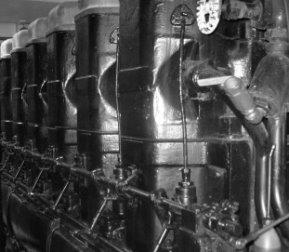
papers on the table my curiosity got the better of me. On top of the stack was a sheet that caught my eye, with a letterhead “Donoghue Barge and Tug Service”. On it was a list of equipment. Two tugs, four barges (one mixed fuel barge with pump) two 100-foot wooden deck cargo barges and one 40-ton crane barge. The address was Barge No. 1, Berth 117, Wilmington, California. I noticed the name of one of the tugs was Vikki Anne. A separate sheet was added with a list of particulars, giving her description:
Constructed 1929 at Haughton Welding, Seattle, Washington …68 ft. overall length…18 ½ ft. Beam…8 ft. Draft…Gross Tons…82 …3/8” steel plate …arc welded (recent improved method).
I searched the engine-room, hoping to find the shore plug-in cord, then went top-side to open the after deck *lazarette hatch. What a wealth of heavy towing and mooring lines. On a row of hooks were *fenders, *heaving lines and the heavy shore cord that took up several hooks.
A fiber tag at the three-prong twist plug end indicated it was to be used only with 110-volt dock line and plugged into the *MG set 32-volt panel. That opened a whole new issue of obtaining light from the boat’s power system. I hunted and found the small MG set and the large bank of batteries that were all in need of distilled water. An hour later I had lights. I even tried the switch on the stove. It worked.
On my way over to move the MTL I stopped at the L.A.P.E. building searching for a vacuum. I found one and lugged it down to Vikki Anne. I got so carried away cleaning I forgot the time. I heard someone calling out from the gangway and went topside. There was the Port Captain, I welcomed him aboard and invited him below.
He was amazed at my progress. I explained the complicated electrical hook up. He took a seat at the table and I handed him the papers and documents that were on the table when I first came aboard. He said they were old history. “Captain Donoghue was the owner and operator of the company but became unable to physically work because of an injury aboard a ship many years ago. His son took over the tug and crane operations, business began slowly going downhill and when the war broke out, the Navy needed the son’s services and that signed the company’s death knell.”
“Do you know anything about Vikki Anne?” I asked.
“Only that the tug was named after the Captains daughter.” He then added, “I take it that you’ll be comfortable here?”
“I’ve developed a close affection for her…The tug I mean.”
“There is an engineer that may be able to help with the MTL and Vikki Anne. I’ll send him over tomorrow. In the mean-time, I’ll run you up to the store and buy a few groceries, then drop you off at the MTL and you can run her back over here and side tie her to Vikki Anne.”
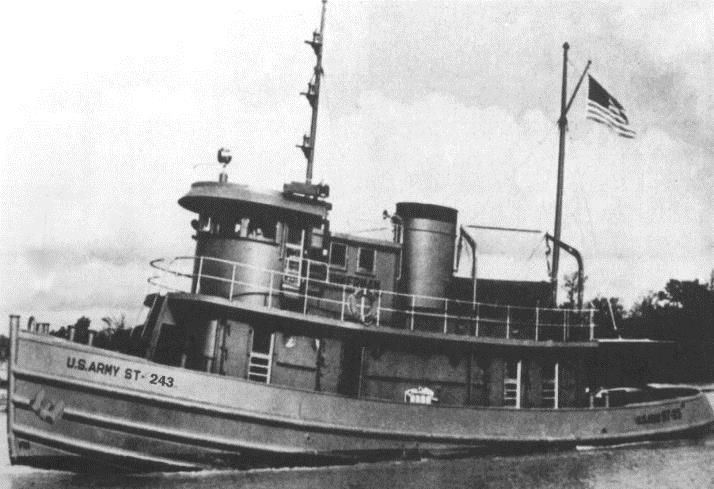
On our way to the grocers, just out of curiosity, I asked the Captain if he knew what assignments were planned for Vikki Anne. He replied that the newly acquired 86-foot ST (steel tug or small tug) with its 10-man crew, tied up too much equipment and man-power for the Army’s Catalina West End supply runs. Vikki Anne had made the run many times, so that’s why the Army requisitioned her out of the Marshal’s sale. “We think she’ll fit in fine with a three to four-man crew, maybe making three runs a
week. The large old 6-cylinder 300-plus horsepower Diesel has more than adequate power to drive her and her tows under most conditions.”
The Captain dropped me and the groceries off at the MTL. I ran the taxi alongside the Vikki Anne and tied her up for the night. After hooking up the water hose from the dock, I hosed Vikki Anne’s topsides, using a scrub brush around the house and windows. The galley had water pressure so I let the water run most of the evening to fill and rinse the tank, letting it discharge over the side. I spent most of the night cleaning and scrubbing the stove and refrigerator. I started a list of bedding and steward’s department supplies needed.
The *head flushed with a hand pump using sea water after stepping on the dump pedal. I had to pump it twenty or more times before it would even start to suck-up water. I guess the leather or rubber valve flappers had dried out.
I worked up a sweat so decided to take a seaman’s version of a ‘whore’s bath’. After finding a galvanized bucket I filled it half full of fresh water then I “washed down as far as possible…washed up as far as possible…then washed possible”. I also rinsed out my skivvies and socks before calling it a night.
Early the next morning I got the coffee started and undogged the *booby hatch (sleeping compartment escape-hatch) propping it open to vent out the fo’c’sle and allowing daylight to illuminate the area, exposing beautiful varnished wooden bunks and lockers. I thought, “What a cozy, comfortable compartment!”
I heard stomping on the decks topside, I called out, “Who’s there?”
A voice responded, “I’m your Engineer. Captain Segal sent me over.”
“Come down the ladder through the *Pilot House, I’ve got coffee and doughnuts…good to have you aboard.”
A small middle-aged fellow stumbled down the ladder. I saw a bald head with a short trim of white hair around the edges. I held out my hand, “My names Ron, I run the MTL next door. The Captain offered this tug as my living quarters. I think she’s pretty neat. Here have some coffee.” I handed him a cup.
After a quick glance around he remarked, “All the comforts of home,” then extended his hand. “My name’s Dan White, good to meet you Ron. Captain Segal says we have a filthy mess on the MTL to clean up. He also suggested that after we get the taxi in working order that I take a look at Vikki Anne’s engine.”
“How much time do we have for your services?” I asked.
“I’m hoping for a while. A week ago, having just returned from a coastwise trip, my wife had a stroke. She’s stabilized now and is staying with our daughter and her husband in Harbor City. I was discharged as ‘Third’ off my last ship, which is now heading offshore. I asked Captain Segal if he had a shore berth so I can spend some time with my wife. He offered me this gig.”
After coffee I cleaned up the galley and straightened up the fo’c’sle while Dan took a peek into Vikki Anne’s engine compartment. On his return he remarked, “What a beautiful engine-room layout.”
We went aboard the MTL to survey what needed to be done. Dan agreed that it was almost a hopeless case and even, only half kiddingly, suggested that, “Maybe we should just take her out and let her sink.” He started the engine and tinkered around adjusting here ‘n’ there. “The engine sounds great. My daughter’s husband is a machine shop foreman maybe he has a steam cleaner we can use, I’ll ask him.”
“I’ll start cleaning out the forward compartment. That is, if I don’t get sick with the stink. If you want, why don’t you go up and give your findings to the Captain on our progress and needs. I’ve made out a list. Check it over, see if there is anything else to add.”
About an hour later Dan came down the ramp pushing a dock cart loaded so high he could hardly see over the top of it. I saw a large fan on top and several large packages. I blurted out, “Who did you rob?”
“All gifts of Captain Segal,” he responded. “I told him if you didn’t object I could stay aboard with you. That way I can scoot between here and my wife when necessary and still do my job.”
“What all did you get?” I asked as we started tearing open the paper bundles. Sheets, mattress-covers, towels, blankets, pillows and pillow cases…there seemed to be everything I had put on the list.
The Captain said Sunshine Grocers would deliver the list of herbs, spices, sugar, flour and assorted dry and canned goods this afternoon. He also told me to tell you that we should concentrate on getting Vikki Anne up and running first, then we can do the MTL.
We made up our bunks with the new sheets and blankets, then stowed the laundry in the closet. We headed for the engine compartment. Dan showed some concern over the 35-volt system until he saw the throw switches with a large name tag ‘Aft deck towing *capstan’.
He checked the batteries; they were fully charged. He started the main engine coolant water pump and I went topside to see if water was flowing. He opened the fuel lines then found a container much like a can of DDT, with ‘Combustion Fluid’ written on it. He gave a shot of spray at the intake manifold and pressed the start button. The starter just growled…nothing.
He repeated the process several times and remarked, “This why I like a ‘day tank’; fuel is always at the ready. Sometimes the injectors lose line pressure.” While waiting for the batteries to charge back up, we found the log-book with notes of major engine events. Listed was the engine operating temp settings at 182 degrees, and a list of oil and filter changes.
About a half hour later Dan gave it another squirt and pushed the starter…she growled…fired…back fired…then took off at very lively RPM turns…oil pressure at 35 pounds…knocking like it wanted to explode. He brought the throttle back gradually, until she was purring like a contented kitten.
Dan let the engine run for nearly 20 minutes, then shut her down. He asked for some time so he could trace the different fuel and water coolant lines. Meanwhile, I went top-sides to check out the pilot house equipment.
After a while Dan popped his head up through the engine-room escape hatch and yelled out for me to double up on the dock lines so we could have dock trials while we slipped the clutch fore and aft. He cranked up the engine, then came to the pilot house and read the gauges…oil pressure 35…temp 185 degrees…generator charging… engine RPM’s…all O.K.
Dan announced, “Now let’s see what she can do…You handle her just like you would the MTL…neutral your throttle…engage the clutch…increase the RPM’s.” I did as Dan instructed. I felt the surge forward, then I reduced the throttle, slipped the clutch to the astern position, then increased the RPM’s and felt the thrust astern along with screeching from the dock lines. Just for kicks I gave a short yank on the horn. We were fully content with our progress.
I noticed Captain Segal coming down the ramp heading our way carrying a large grocery bag. As he approached I offered a hand as he climbed aboard. With a big grin, he slapped me on the back, “I hear you guys got her up and running. How did she do?”
I shouted for Dan to come on deck. “Captain Segal just came aboard and wants to know how the dock trials went.”
Dan climbed up through the engine-room *fiddley escape hatch, grabbed the hose and showered himself. “Sorry Captain, I was in cramped quarters tracing fuel lines. We’ve got ourselves a jewel! She started right up and works like a fine-tuned watch. Of course, we won’t know how good she really is until we take her out and put her through her paces at sea trials.”
The Captain said, “Let’s go below and have lunch, I brought some sandwiches and soft drinks, then we can discuss our next move.”
I led the way below, adjusting output of the fan which was now sitting in the booby-hatch, and hurriedly found a clean tablecloth and set-ups for lunch.
“Besides bringing lunch,” the Captain said, “my main reason for coming down was to inform you that we now have ‘Title and Possession’ of Vikki Anne. I’m on record as the Captain…and I’m appointing you, Ron, as the skipper. Now don’t do anything that will embarrass me. The powers that be have decided to put the MTL on hold for a while.” He looked around the fo’c’sle and remarked. “I’m jealous, this is the ‘man’s cave’ every guy dreams about.”
“Captain,” Dan said, “I have a process I should go through before I give my blessings for a sea trial. I’ll need two clean 20-gallon drums to transfer and strain the fuel from the tug’s fuel tanks. I’ll also need a rotary pump and filters. I’ll write a list of any other of my needs. It shouldn’t take more than a few hours once I get started. I plan to go visit my wife over the weekend and may be able to get a steam cleaner from my son-in-law’s company, if you can arrange for a pick-up and delivery truck; otherwise we’ll have to pay by the hour for their man to stand by.”
“What about you Ron are you O.K. for the weekend?”
“Thanks for the lunch. I might play around a bit with the MTL, but there’s plenty to do on Vicki Anne, she’ll keep me busy. We have stores coming this afternoon so I’ll be OK…oh by the way…is there any chance we can get a dedicated radio for communicating with your office instead of that dock phone?”
“I’ll have Marine Radio come down, sometime next week and check out everything. Then, when all is up and running, I’ll get together with you guys and we’ll *swing the compass.”
The Captain was about to leave when I asked him why he was so concerned with the Vikki Anne. I told him I felt the he showed more than just a little bit of personal interest in her.
“I got my first taste of seamanship as a youngster on an old steam tug much like Vikki Anne, working the logging waters around Puget Sound. I had a salty old skipper that taught me the real ‘rules of the road’ by whacking me whenever I screwed up, which was all too often. He did give me a recommendation for a deckhand position on a freighter going off-shore. Fifteen years and many ships later…I still long for a skipper’s berth on a small tug. I guess my mind wants me to slow down, but I have a war to tend to. I gotta go…see you both Monday, bright and early.”
Dan walked up the ramp with the Captain to call his son-in-law about the steam cleaner and ask him to come and pick him up for the weekend.
Late Friday afternoon Sunshine Market came with a huge load of staples. Their driver made several trips bringing the goods down and placing them on the deck. My problem now was ‘where do I stow the stuff.’ From the amount of groceries provided, they must have thought that we were a ship heading for the South Pacific.
First thing Saturday morning I went for a long walk towards town, stopping a Costello Supply. I bought a one quart can of cream colored paint for the MTL’s fo’c’sle and a can of green for Vikki Anne.
Returning, I started to thoroughly clean Vikki Anne’s living quarters and galley. I found a three-hole loose leaf binder and decided to make an inventory of the after lazarette compartment, which held all the *blocks and tackle, *towing hawsers, *shackles, and *snatch blocks.
While having lunch under a makeshift awning by the after *towing bitts, a Harbor Police Patrol boat spun around and backed up to my stern. An officer with sergeant stripes asked. “What’s happening with the Vikki Anne?’
“The Army just got title to her and we’re getting her ready to put her to work,” I replied.
“I always admired her…especially when Donahue’s son ran her and kept her in tip-top condition.” The Sergeant added, “I haven’t seen the MTL running for a couple of weeks, is she out of commission?”
“Not really, her bilge is full of oil and waste. We’re waiting to take her out to sea and pump her out.”
“Why don’t you call the Sanitation Department, they’ll send out their boat and suck her dry. Here’s their extension.” The sergeant jotted a number on one of his business cards.
“Thank you, Sergeant, and you guys have a good day,” I shouted as they revved up their engine and departed.
On Sunday I promised myself to polish Vikki Anne’s pilot house. After polishing the large beautiful wood spoked *helm, I took the teak pilot house and galley floor *gratings out on the *fantail and scrubbed them. As they were drying, I painted the pilot house deck dark green.
On Monday it was nearing 10 am and no sign of Dan; I wondered if his wife might be having problems.
The Harbor Sanitation barge came by and said a Sergeant from the Harbor department told them that there was a boat that needed its bilge pumped out. I pointed to the MTL and they maneuvered around. A man with a hose clambered aboard, went below and quickly reappeared, yelling, “What a god-awful stink!” He went aboard his barge, donned a mask and went back down with the hose. He soon reappeared and gave his man on the barge a high sign. The pump started up and within 3 or 4 minutes he reappeared and made a sign like cutting his throat and the pump stopped. He took a garden hose and washed the bilge area then pumped it out again. The whole operation didn’t take much more than twenty minutes. I signed some forms and they were off.
A small GI truck with a boom attached to a steam-cleaner appeared at the Catalina Terminal dock. I started the MTL and ran it over to the truck. Dan was there and assisted lowering the cleaner to the MTL. They off-loaded two small drums and a box with a pump and several crates of filters. The truck took off and we ran the MTL back to our dock.
“How’s the wife doing?”
“She’s doing wonderful. My daughter said the Doc indicated that it was a minor stroke and she should recover in time.” He added, “How was your weekend?”
“Great, I pumped out the MTL, took inventory of Vikki Anne’s lazarette, polished all the wood in the pilot-house, scrubbed the gratings and painted the deck.”
Dan jump down onto the MTL in disbelief and went below. He came back up shaking his head, “There is no way you could have gotten it that clean with what tools we have.”
“O.K. so I lied a little,” I said smiling. “The harbor is trying a new requirement to get the vessels to use one of their tanks as a ‘dump-tank’ and they’ll come and pump it out.” With all the heavy ship traffic, they said the harbor waters were becoming like a filthy toilet. They came by first thing this morning and pumped her out. Now, that the cleaner is here I’ll go down and try to steam-clean the fore-peak and we might as well do the engine.”
I hooked up the natural gas hose from the Flamo gas cylinder and lit the burner jet. It took about 15 minutes for steam to start spewing from the nozzle and another ten before there was pressure. I took the nozzle below and started spraying. After a minute or so I was totally fogged in. I pointed the nozzle where I thought it would do the most good; the overhead, deck, bilge and engine. I backed out to fresh air, letting the nozzle continue to spray under water over the side. After a few minutes, to let things dry out, I went below to check on my results. What a difference. All it needed now was a little scraping here and there, new paint, and she’d be good as new.
I asked Dan if he thought his engine-room could use some steam cleaning while we still had pressure. He declined. He was too busy straining the fuel tanks. He explained that he found water at the bottom of one fuel tank and that this was a common problem when tanks were left with little fuel in them. The tank would sweat, then condensate sets in and produces a mold which clogs the filter system.
I secured the steam-cleaner and took a quick hose-off to clean myself up. I knew Dan was drenched in sweat and fuel so I told him that I would fix lunch. I opened a can of Spam, sliced it as thin as I could, lightly fried it and made sandwiches with onions, mustard and pickles. I had previously mixed Grape Kool-Aid in a large square Mason jar that just fit in the reefer below the stove and was cool enough for lunch.
Dan took a break from his project in the engine-room, cleaned up and came down for lunch. During lunch we tossed around what lay ahead after we got Vikki Anne up and working. Should we have areas of responsibilities, should we establish times when one of us is to be on call, how should we share the K.P. duties?
I suggested we ask Captain Segal to try to assign us another crewmember. If we were going to tow barges to Catalina, that’d take near four hours and if we had any maneuvering with the barges it’d take at least three of us. Maybe we could find someone that would be willing to split his time between being a deckhand and a cook. I asked Dan if he’d be willing to work on deck when needed.
“I told the Captain I was willing to work wherever I was needed…even a shore job.” Dan grinned, “This job is better than I could have ever hoped for,”
After cleaning up the galley I was just about to head for the MTL when I saw Captain Segal and another guy, with their arms loaded, headed down the ramp. I assisted the guy, who had an armful of radio gear, clamber aboard. The Captain introduced him as Frank from Marine Radio. He went directly to the pilothouse with his gear and started work. Dan and I followed the Captain below.
The Captain grabbed a cup of coffee and asked, “Well, how much more work is needed before Vikki Anne’s ready?”
I thought his question was put to Dan and waited for his response before offering my assessment.
“We could be up and running within the hour. I got rid of all the condensate from the fuel tanks. The engine-room is ready.”
“And you Ron?” Captain Segal looked in my direction.
“I traced and took up the slack in the steering system and repacked the rudder gland, we’re ready to go.”
“Then let’s do it.” The Captain hollered up to Frank. “Hey Frank, want to go for a boat ride?”
“I have to go back to the shop and pick up some fuses and tubes. I’ll be back within an hour,” Frank replied.
“We should be back by then, we’re going to get fuel then see what she can do at the *mile markers in the outer harbor.”
Frank jumped off and stood by to toss the bow lines. Dan was handling the stern line as I started the engine. I did one long blast on the horn to let everyone know that we were leaving our dock, then three short toots, as we back away from the slip. A procedure I always did on the MTL. I was proud to be at the helm, thinking to myself, “She responds almost like she anticipates my next maneuver.”
Leaving our channel, I offered Captain Segal the helm. With a big smile he took the wheel, saying he was just about to shove me aside and take over.
We pulled up to the fuel dock and took on several hundred gallons in our two tanks (good thing we had the Captain along to handle the paper work) then on to the breakwater and mile markers.
Above the windows on the forward bulkhead were a line of gauges: engine temp, oil pressure, amperage charging, engine rpm and propeller shaft rpm gauges. Colored lines, red, green and amber were painted at various stages of the propeller shaft gauge. I took them to mean slow, cruising and *flank speeds.
We revved her up to the green mark on the shaft rpm gauge as we approached the range marker. The Captain kept watch on the second sweep hand of his watch as I aligned the flat face of the helm and when we crossed the marker I called out ‘mark’. Five minutes later I yelled mark again. Twelve miles an hour equals 14 knots.
The Captain said, “Let’s reverse course.” We came up with very similar statistics. “Fourteen knots, not bad for the old gal,” he said, chuckling, then added, “Let’s head for home.”
On our way back to the dock both Dan and I brought up our thoughts regarding another crew member with the Captain. His response was that he had been giving the new crewman a lot of thought. “The man must be agile enough to jump on a barge and knowledgeable enough to handle the lines and *bridles. There is a young man, that would fit that description on the ST, but the skipper wants to keep him. We’ll see…” He turned to Dan and asked, “You do have a *Pumpman’s endorsement, don’t you? Associated Fuel & Oil Supply is running behind in delivering fuel. Now that we have a *bunkering barge we can supply our own vessels. Are you up to it?”
“Yes to both your questions, when do we start?”
“Right now.” Captain Segal then looked in my direction, “If you’re ready.” Then added, “The ex-Captain of the new ST volunteered to act as ‘local navigator’ until you get the hang of it…OK?”
He stepped into the pilot house and flipped the transmitting switch on the new radio. “Home base…home base, this is Captain Segal on Vikki Anne…send down Mister Mackay. Over and out.”
A tall, middle-aged muscular fellow came down the ramp. I recognized him from the MV (motor vessel) Schofield, an old heavily constructed wooden vessel common in Scandinavian waters, now serving the L.A. Port of Embarkation as a utility vessel. She was a highly sought crew assignment.
“Hi, Mister Mackay, glad to have you aboard,” I said as I offered my hand. In maritime parlance ‘Mister’ is often used as a sign of respect for a licensed Officer, be his position Mate or Engineer.
“You two know each other?” inquired the Captain.
“Mister Mackay is the man that broke me in on an MTL.”
Mackay said “I just talked to Associated Fuel. They said your barge is loaded and waiting at berth 118.” Turning to the Captain, he asked. “Are you going with us Captain?” The Captain shook his head ‘No’. “O.K.” said Mackay, “We’ll pick up the barge and head out to the two Coast Guard FS’s at anchor in the outer harbor.”
Berth 118 was next to Vikki Anne’s old home slip and as we arrived at the fuel dock a dockhand welcomed us, “Glad to see the old gal back working again.”
We dug out the large *sisal fenders from the lazarette and hung them over the side while Dan went aboard the fuel barge to familiarize himself with the pumps and hoses.
Mister Mackay explained how he would position the tug to have the most maneuvering control. We would position aft of the barge on the port side, with the pump-man standing lookout on the barge.
We hooked up with the fuel barge and headed out the main channel, searching for the two anchored FS boats and finding them in the lee of Reservation Point.
We then off-loaded several tons of fuel to both boats and headed back to Associated dock, secured the barge and returned to our slip.
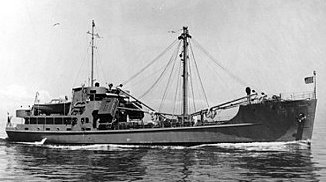
We reported in to home base via our new radio and were told that Captain Segal wanted to meet with all of us up in his office after we secured the Vikki Anne. I responded, “We’re on our way up.”
The Corporal at the front desk ushered us to the Captains office and on the way beckoned for a man to come and join us.
“Ron, Dan, meet your new deckhand, Jack Vigil,” Captain Segal announced as we came into his office. Turning to Mr. Mackay, he bowed his head and looked sheepishly up at the man, “Uh…Mister Mackay, can I prevail on your expertise one more time? I hate to ask this, but I can’t think of anyone else who has the experience and knowledge of towing barges to West-end as you. The new ST is on her way to San Nicholas Island, out of Port Hueneme with a tow. The Army wants what’s on those barges loaded and waiting at Berth 56…now!”
Mackay smiled and rolled his eyes heavenward, “How can I refuse…You haven’t forgotten that you promised me time ashore before I take over on that old steam schooner for the Pacific?”
“I promise…I’ll make it up to you.”
We immediately headed to the East Channel near Warehouse, No. 1, in San Pedro and spent time familiarizing ourselves and setting up the bridles and towline assemblies. The new deckhand took direction well and was agile enough to hop from barge to barge.
We took the two barges in tow and exited Angel’s Gate at sundown. Once outside we eased out our 8-strand braided, 3 ¼ inch diameter hawser and jockeyed the speed until the comfortable ocean swell let us know we were working at a good pace for the barges and still making good time.
A surprise bonus…our new deckhand, Jack, busied himself in the galley fixing dinner without even being asked. I asked him, how he knew we could use a cook. His response was, “Captain Segal offered me a chance in the deck department if I would share the cooking duties. When they first hired me they only offered me a mess-man’s job because of restricted vision in my right eye. I believe that I can work on deck as good as any other man.”
After dinner Mister Mackay, Dan, and I, were in the pilot house and I brought up the previously mentioned Steam Schooner and asked if she was a sailing vessel.
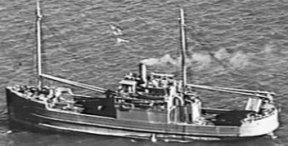
Mister Mackay smiled, “Not at all; the term ‘Steam Schooner’ was applied to wooden built sea-going vessels originally designed around the turn of the century to haul lumber from the Pacific North-West to California ports for trans-shipment to the east. Timber was plentiful and most men
were already familiar with its creative uses. It was only natural for the industry to build their own vessels to get their product to market, be it by barge, boat or giant rafts.
Transporting steel from the East to construct ships was much too expensive. During the wars, with steel being in short supply, wooden constructed ships were the answer.”
“Why are you involved? It sounded like you might be taken on as the new skipper.”
“The Captain has a health problem and needs to be near medical services, so that keeps him from sailing off-shore, he re- quested shore duty.
“Do you remember when I asked you to dip into Boschke Slip on our way back from refueling? Those two ships off-loading lumber were Steam Schooners.
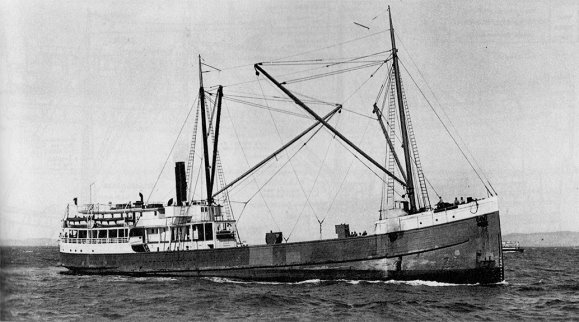
The larger one was ‘San Diego’ a three-islander and the other was ‘Hoquiam’ a stem-winder. The one I’m assigned to is sister to the San Diego.”
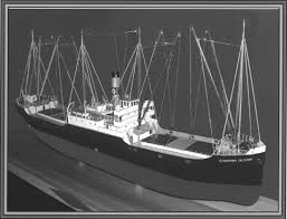
“In the 1920’s and early 1930’s, all World War I mass-produced steel 250-foot ‘Laker Ships’ became surplus and were selling at scrap metal prices. The Pacific Lumber Companies took advantage and put many of them to work.”
Jack came into the pilot-house after doing his galley chores and asked when he was scheduled to stand a wheel watch.
Mister Mackay suggested that he go aft and watch the tow’s reaction to the swells on the tow-line for a while. When you’re steering you also have to know how the tows are doing.
The trip over was uneventful; everyone took their turns handling the helm. On our approach to the Isthmus we took in most of the hawser, *faking it neatly on deck. We separated the barges, tying one up to a buoy while we maneuvered the other to the makeshift dock that the Army shared with a Marine Research Institute.
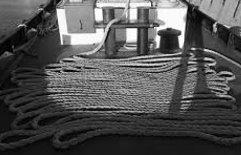
This procedure went on for three weeks and was becoming almost a boring routine. We, the crew, felt Vikki Anne was capable of doing other work but any suggestions fell on deaf ears. That was until…one day we were on our way to hook up to our barges when we received a call from home base. “Vikki Anne…Vikki Anne…This is home base please come in…over.”
“This is Vikki Anne…what is your message…over.”
“Go to alternative frequency…now!”
“LT 153 is having trouble…a leg of her bridle has parted…she cannot retrieve her towing wire…she’s five miles off Newport…Go to her assistance…now…you can talk to her on this frequency…over.”
“LT 153…LT153…this is Vikki Anne…we are on our way…our estimated time of arrival is one hour…I repeat Vikki Anne…on our way…ETA one hour…is that Ok?…over.”
“This is LT 153…We receive you loud and clear…over and out.”
As we departed the ASW (Anti-Submarine-Warfare) nets at Angels Gate, we picked up a lively swell driven by a thirty-knot breeze. Vikki Anne’s actions reminded me of my surf boarding days. We were clipping along at 14-16 knots as I took running fixes on navigational targets.
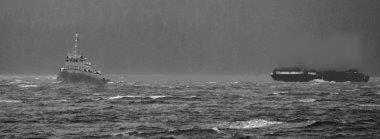
An hour into our run, we saw the two vessels directly ahead. I tried hailing them on the alternative frequency but got no response. I figured they were too busy at the moment. I tried the *Aldiss signal lamp just to let them know we were there.
We approached on their weather side and spun around to run parallel to their course. We could see men huddled around the towing winch area. It appeared that all their wire was paid out and that only a single length of the chain bridle was still attached to the port side bitts, causing the huge barge to veer off to the right.
The LT 153 was barely making headway; we came within hailing distance and offered, “How can we be of assistance?”
The radio came alive, “Hi, Vikki Anne…sorry about not answering…I had my head out the door trying to listen to the Skipper’s instructions…here is our problem…The starboard side bridle chain parted…our *winch level-wind cog broke while jammed to one side and can’t be moved…They are dismantling it now…we may lose the wire…we only have six turns on the drum…we cannot retrieve or pay out…over.”
“If we can connect to the *flounder-plate…maybe we could hold a strain while your men clear the winch…over.”
“The 1 ½ tons of weight and several hundred feet of 2 ¼ inch wire over the side is the problem…We’re sure it’s dragging bottom.
Captain Walsh thinks we can release the wire, then *grapnel and retrieve it later…over.”
“How can we help? …over”
“Stand by…over”
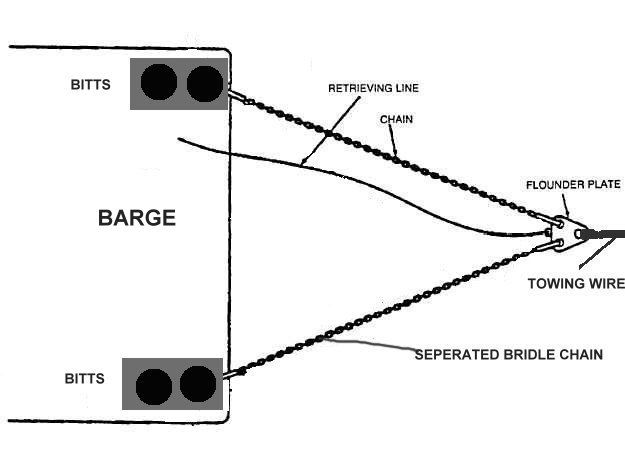
“Hello Vikki Anne… The level-wind is dismantled…the wire is free…we cannot use the winch…Captain Walsh wants to transfer two men to the barge to release the good leg of the bridle and only if necessary, take aboard several mooring lines to assist holding or towing…can you transport them?…Over.”
“Will do…we will come to your *lee-side…over.”
We maneuvered around the backside of the barge looking for the most likely spot to off-load the men. We worked our way up through the choppy seas, slowly creeping our way alongside the sheltered side of the LT. The two men threw their tools over on top of our *faked towing hawser. Because they were wearing foul-weather gear, their bulk curtailed their willingness to jump. Because we sat so low in the water and the LT.’s *freeboard was much higher. I brought our bow into their tugs mid-section; they then jumped, one man at a time. They had several minutes to orient themselves on Vicki Anne while we maneuvered alongside the barge in the choppy waters.
The first man flew across to the barge and we started tossing their tools on the barge. The second man made it across taking a heaving line *bent to 50 feet of 1 inch manila *lanyard. The lanyard was attached to our 12 foot-wire pendant which, in turn, was spliced to our hawser with thimble and shackle so they could secure our towing hawser to the barges starboard bitt. We slowly took a strain, all the while feeding out about 150 feet of our towing hawser.
“Hello 153…this is Vikki Anne…we have control and are able to tow…You can release your drum cable-clamps…your men on the barge can start hacking away at separating the bridle chain…over.”
“We are free…we will come alongside the lee side of the barge and put a couple of men aboard, then we’ll see about rigging a towing arrangement…over.”
We came through the southern opening of the ASW net, proudly leading the barge with the LT tied alongside. Maybe no one else noticed, but Dan, Jack and I, huddling in the pilot house, had very proud smiles on our faces showing signs of contentment for a job well done.
As we approached the shelter of Reservation Point the LT took her port side aft position to navigate up the main channel while we took the forward starboard side position.
Once the barge was secured at the dock we moved to our two barges at the opposite end and prepared to drag them to Catalina.
Captain Walsh came aboard with his Mate, who had relayed the messages between LT 153 and our tug on the radio. Introductions were made all around and the Captain expressed how appreciative he was for our assistance and was going to let Captain Segal know how the Vikki Anne proved herself. Captain Walsh said the boat-building yard was going to replace the towing winch and make arrangements to recapture the wire.
We hooked up to our tows and headed towards the Isthmus. About three quarters of the way over, the seas started kicking up. We were monitoring the emergency frequency when, suddenly, there were announcements of high winds and seas coming from several vessels from as far north as San Nicolas Island and south into our area.
Our seas at the moment were 6-8 foot and a lively breeze of 20 knots had just started to create rolling white caps on the swells. We reduced headway in anticipation of the supposed blow approaching, even though our barges, with their blunt bows, rode steady and true. As a precaution I searched the charts for a sheltered cove, just in case it was needed. Long Point was a bit far and yet the closest.
Within a half hour we were safe and secure at the Isthmus. We separated the tows, leaving one at the University’s Marine Institute dock and the other one side-tied on the buoy. Before bedding down for the night Jack and I listened to the chatter on the emergency frequency; Dan turned in. Jack filled me in on his attempts to join the services and being rejected because of poor vision in his right eye. While chatting, we heard the first call, “Hello…Hello…Hello…this is Steamer Salem out of Grey’s Harbor…bound for San Diego…loaded with lumber…our preventer chains have parted…our starboard deck load is running free…we are taking a 30-degree list…we are 6 miles off the west end of Catalina Island…This is a hazard to navigation advisory because of heavy timber floating free…I am not calling an emergency at this time…please stay alert…over and out.”
“Hello Salem…This is Army Tug Vikki Anne…out of Wilmington…now moored at the Isthmus…we hear you loud and clear…we are available…over and out.”
“Thank you, Vikki Anne…over and out.”
I put in a hail on our home base frequency, making them aware of a possible change of plans on our return home in the morning. Within a half hour we heard our name repeatedly called out. “Vikki Anne…Vikki Anne…this is Captain Segal…go to Salem’s aid…Offer any assistance necessary…she is an Army vessel…I repeat go to Salem’s aid…this is Captain Segal…over and out.”
I told Jack to wake Dan and have him crank up the engine.
Leaving the calm and protective waters of the Isthmus, we ran directly into the storms onslaught; no warning, just BOOM and we were bouncing around like a cork in my mother’s washing machine. I got a gut feeling that the Almighty was putting us to a test…but, was the test for the Vikki Anne or me?
Plowing our way out, and making very little progress, we saw the silhouette of Salem dead ahead and about three miles off. We hailed her on the radio and informed her that we were instructed to offer any assistance we could provide, adding that the Vikki Anne was an Army tug. I offered a suggestion; since they had passed the chance to enter the shelter of the Isthmus, that they continue to hug the coast of Catalina and turn in at Long Point, as that was the only deep-water shelter until they reached the island’s lee at the far end past Avalon.
“Vikki Anne…we appreciate your, local knowledge input…Long Point it is…over and out.
We continued on our course out beyond Salem, and then headed South-East, searching for any traces of the dumped cargo.
We finally came on what appeared to be a low flat island. The heavy timber was surrounded with very little wave action, so had any vessel made contact, they would have suffered serious consequences. We radioed its location and drifting progress on the emergency frequency.
We made up a heavy-duty grappling assembly, attaching it to our towing hawser. We made several passes on the raft of lumber in our attempts to somehow snag the mass. We finally succeeded.
The gale force winds were subsiding, easing the chop of white caps atop the ten-foot swells. The raft fell slowly in line behind us as we took an easy strain heading towards Long Point, six miles away.
We saw the Salem safely at anchor in the lee of the point, beginning to off-load her deck cargo of wood bundles alongside her hull.
I hailed her on the radio informing her that we were bringing in her raft of spilled lumber and suggested that since we had two empty barges we were going to tow to San Pedro, why not load the Salem’s deck cargo aboard the barges?
We towed the spilled lumber raft alongside and secured it to the Salem, then took off for the Isthmus to grab the two empty barges, informing the ship that we should be back in about two hours.
On our return, we spent nearly four hours shifting lumber from the raft to the first barge and removing the deck-load lumber to the second barge. Evidence of a parted preventer chain was found and when it released, it wrapped itself bundling up the spilled lumber.
Salem informed us that they were directed to alter their plans and head for Los Angeles Harbor. We made contact with home base, giving them an approximate on our ETA. Our trip home was easy with a following sea and breeze. Another job well done; again, we all sported smug, proud smiles.
Awaiting orders on our next trip to Catalina, we were instructed to go to a shipyard to be hauled out and *surveyed.
I received a list of the work ordered: Pull prop, shaft and rudder. Open all thru-hulls and sea-cocks. Sand-blast bottom and sand-sweep topsides, replace all *zincs and repaint entire vessel.
I met with Captain Segal and he explained that when there was a transfer of ownership a survey was required to identify and describe in detail the vessel. He also added there was to be a name change to conform to Army Transport Policies. Vikki Anne was to become US Army MTL-plus five to ten numbers after.
I begged the Captain to please reconsider as Vikki Anne deserved a better ID than that. In the last month alone she had proved her value.
He responded, “If you guys can come up with something better I’ll consider it.”
Two weeks in the shipyard and Vikki Anne was transformed into yacht condition. New paint…evidently Captain Segal departed from the rigid military tradition of painting everything either grey or green and went with a black hull and cream topsides.
The yard, being very familiar with Vikki Anne as they had hauled her many times over the years, gave her special attention in every detail. She sported ‘US Army MYT-1’ as her new ID number on both sides of her bow and on the front of the pilot house, a sign painter created this image.
“Mighty 1” became her call sign.
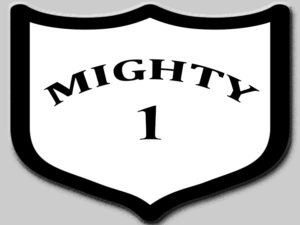
Several months later I heard that Mister Mackay took command of SS SALEM and delivered her to Milne Bay at the East end of Papua, New Guinea, loaded with pilings for the construction of wharfs and piers at Lae and Finschhafen, as the allied military advanced in that part of the Southwest Pacific war zone.
Me? I proudly skippered Mighty 1.
*Glossary of Nautical Terms
Aldiss Signal Lamp Hand held blinker light.
Bent Tied together.
Bilge Lowest compartment on a vessel.
Blocks & Tackle A shell with pulleys (sheaves) to haul in rope or cable.
Booby Hatch Small hatch giving access to the weather deck of a vessel.
Bridles Lines leading from each side of barge, joining together at flounder plate and towing wire.
Bulkhead Wall.
Bulwark Vertical extension of the hull for protection from seas on deck.
Bunker Fuel
Capstan Large power turning head to winch in line.
Faked Hawser Towline laid out on deck in neat patterns. (see page 17)
Fender Manila woven, bundled and spliced to cushion bumping.
Fiddley Engine Room overhead venting and escape hatch.
Flank Speed High Speed range.
Fantail Flared after deck.
Flounder Plate Steel triangle plate, joining bridles and towing wire. (see page 19)
Fo’c’sle (forecastle) Forward part of vessel, usually crew quarters.
Freeboard Safe distance from water to top of hull.
Galley Ship’s Kitchen.
Grapnel Steel multi-hooked snag attached to towline.
Grating Wooden lattice to allow draining of decks.
Head Toilet.
Heaving Line Light line with weighted end to throw to wharf or vessel.
Helm Steering Wheel.
Lanyard Short length of line.
Lazarette Below after weather deck, storage area.
Lee Side Sheltered side, out of the wind.
MG Set Motor-Generator all-in one Combination.
Mile Marker Markers set at one mile on LB breakwater.
Ocean Operator Required Document to Operate Small Vessel.
Pilot House Wheel House, command area on tugs.
Pumpman’s Endorsement Required Document to operate bunker transfer pumps.
Shackle Heavy metal U shape coupler with pin to join chain links.
Snatch Block Quick side opening shell with pulleys.
Survey In-depth inspection and evaluation process.
Swing the Compass Adjusting magnets to correct compass card deviation.
Towing Bitts Large shaped “H” to secure wire or ropes. (see page 15)
Towing Hawser Large circumference Hemp braided rope.
Watertight Hatch Door with locking levers.
Winch Level-wind Mechanism to lay wire in neat rows on drum.
Zincs Sacrificial metal used to prevent corrosion of more noble metals.